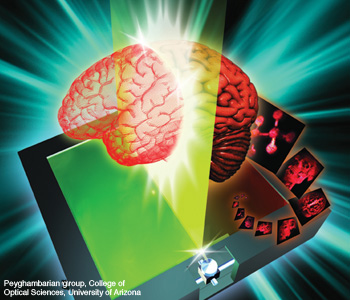 Artist’s conception of a dynamic 3D display.
Artist’s conception of a dynamic 3D display.
Like lasers, holograms have played almost as prominent a role in science fiction as they have in real life and real science. Holography was the inspiration behind the holodeck on Star Trek—the simulated reality facility aboard the starship Enterprise—as well as the 3D holographic film of Princess Leia in Star Wars (“Help me, Obi-Wan Kenobi. You’re my only hope.”).
Of course, behind the science fiction glamour, holography is a well-established technique with a solid theoretical foundation. Pioneers such as Gabor, Leith, Upatnieks and Benton have developed an amazing array of applications that use holographic optical recording and processing. These include non-destructive testing and evaluation, holographic data storage, nano-fabrication, and the diffractive optical elements used in spectroscopy, laser beam combination and telecommunication. Unfortunately, the lack of suitable recording materials has limited the realization of dynamic 3D displays like that memorable one of Princess Leia.
We believe that photorefractive (PR) polymers may provide a solution. For nearly two decades, our research group at the University of Arizona has been studying these unique, high-performance, reversible holographic recording materials. In previous studies, we’ve improved the diffraction efficiency of this material from a fraction of a percent to nearly 100 percent; demonstrated a near-IR-sensitive PR polymer; created a security verification system using PR holograms; showed the PR effect by two photon absorption in a polymer; and operated a PR polymer at an optical communication wavelength.
Now, in our most recent research published in the February 7, 2008, Nature, we have demonstrated updateable holographic displays based on PR polymers. The holograms persist for several hours after they have been written and then can be erased and written again. A series of holograms—when captured quickly on a photorefractive material—might be used to create the effect of 3D movement.
Benefits of holography for 3D displays
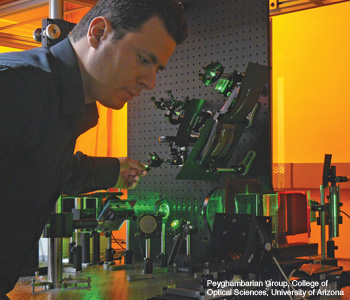 Savas Tay aligning the 3D display optics.
Savas Tay aligning the 3D display optics.
Humans have been designed to see the world in three dimensions, thanks to the horizontal separation of our eyes and our brain’s extraordinary ability to process images. Three-dimensional images differ from two-dimensional ones in that they allow viewers to perceive depth through various cues, such as stereo parallax, accommodation and depth of field.
Two-dimensional displays such as televisions and computer screens are not capable of providing these depth cues. The result is a reduced sense of realism and the loss of a great amount of information related to the object or scene of interest.
Researchers have worked hard to develop 3D display technologies that overcome the limitations of 2D displays. Some of the most noteworthy approaches to 3D displays are stereoscopic displays based on special eyewear, volumetric displays that record bright spots in the bulk of a material and holographic displays.
Among these, holographic displays stand out because they can provide extremely realistic, high-resolution and full-color images that actually float in midair. Moreover, they are available in very large sizes—an important property for displays—and are capable of displaying images up to several meters across. Moreover, 3D images produced by holographic displays are autostereoscopic, which means they can be viewed directly on the recording material from multiple angles and do not require special goggles or other eyewear.
Limitations of recording materials
Most successful recording materials that have been used in holographic displays include photographic emulsions and photopolymers. These materials have several advantages: They are capable of extremely high spatial resolutions and they have the diffraction efficiencies needed to create high-quality images and large viewing angles.
However, because they are based on irreversible recording processes that result in permanent holograms, current commercial holographic displays are write-only systems—meaning that
the images displayed cannot be erased and updated with new ones. This lack of “rewritability” has limited the use of holographic displays to static appli-cations and increased the cost of 3D imaging considerably.
In previous attempts to create dynamic holographic displays, researchers used acousto-optic, liquid crystal and MEMS-based devices to project 3D images. Each of those devices are capable of very high refresh rates (up to several KHz) that allow them to create video-rate images (30 frames per second). But the fast response times come with a price: The recorded images do not persist.
The lack of memory requires that the entire display be refreshed at a rate higher than the video rate to avoid image flicker. As a result, dynamic holographic displays have been limited based on optoelectronic devices to small sizes and resolutions.
But there is an intermediate regime between static and real-time imaging, called near-real-time imaging, where images are updated every few minutes. For many applications of 3D displays, such as medical and military imaging, the 3D data cannot be generated in real time due to limitations in image acquisition or the sheer size of the data sets. Near-real-time displays are naturally suited for these scenarios. However, in order to realize practical applications of near-real-time holographic 3D displays, large holographic materials with reversible recording capability and memory are needed.
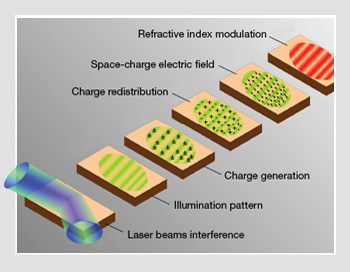 The photorefractive effect.
The photorefractive effect.
Holographic materials for rewritable 3D displays
To be used for updateable 3D displays, holographic materials must satisfy certain requirements, such as high diffraction efficiency, high sensitivity, reversible recording, high spatial resolution, large area, fast recording and long storage time. Although it is not difficult to obtain materials that satisfy some of these properties, finding their combination in a single material is quite a challenge.
Specifically, fast recording and long storage (persistence) rarely come together in a single material. The table below summarizes the requirements for holographic materials for use in rewritable 3D displays and lists the properties of candidate materials. Here, we focus only on materials that have the potential for scaling to the large sizes necessary for holographic displays. As the table shows, photorefractive polymers stand out as attractive candidates for updateable holographic displays.
Photorefractive polymers
PR polymers record holograms by virtue of the PR effect, in which a three-dimensional refractive index pattern replicates the non-uniform interference pattern formed by two laser beams.
In the first step in the PR effect, light is absorbed in the bright regions of the interference pattern. Following this, an internal space-charge field is formed due to selective transport and trapping of the photo-generated charges. In most organic systems, the conduction of holes is energetically favored over that of electrons, resulting in a hole-dominated space-charge field.
The space-charge field in turn creates an electric field pattern that replicates the original interference pattern with some phase shift. In the final step of the process, the electric-field-induced refractive index changes through the electro-optic effect and/or birefringence. This is achieved by loading the PR polymer composites with large percentages of nonlinear chromophores—rod-shaped molecules with large hyperpolarizibility—which are poled through an applied external voltage. The poling improves the ordering of the molecules and enhances the drift of the charge carriers, thus enhancing the nonlinear response and the size of the refractive index change.
The PR effect is fully reversible and does not exhibit any fatigue: Trapped charges can be de-trapped by uniform illumination of the recorded image, resulting in the elimination of the nonuniform charge distribution and the index modulation. The erasibility of the PR gratings allows the holograms to be refreshed indefinitely.
The PR polymer is a copolymer host with tetraphenyldiaminobiphenyl-type and dicyanostyrene in the ratio 10:1. We added a fluorinated dicyanostyrene chromophore to enhance the nonlinear optical properties and a plasticizer, 9-ethyl carbazole, to reduce the glass transition temperature so the chromophores could be aligned. We formed the composite into thin-film devices by melting it between two indium-tin-oxide-coated glass electrodes.
Holographic stereoscopy
We used the holographic stereography approach to generate 3D images in PR polymers. This is a well-established method based on the optical multiplexing of a limited number of perspectives onto different parts of a recording medium—in this case, a large-area PR polymer thin-film device. First, perspective views of an object or scene of interest are generated from 3D data. These data can come from a computer model or any kind of 3D imaging system, such as MRI, CAT scan, tomography and confocal microscopy; thus, this work has potential applications in medicine and aerial-, satellite- or radar-imaging for military purposes.
The perspectives were then divided into multiple 2D image planes, which were re-organized in 2D matrices. We uploaded these matrices, called holographic element (hogel) data, to a spatial light modulator (SLM). The SLM that is illuminated with a laser beam displays the hogel data in sequence with the translation stages and an electro-optic laser shutter.
The laser beam modulated by the SLM is called the object beam, and it illuminates the hogel area on the polymer device. A coherent reference beam simultaneously illuminates the same area, thereby recording the hogel through interference with the object beam and the PR effect. The hogel contains perspective views from all angles of the corresponding pixel in the actual object or scene. After one hogel is recorded, the laser beams are turned off, the polymer device is translated to the next hogel position, and new hogel data are uploaded to the SLM. Once completed, the holographic display can be viewed using a reading beam from a narrow-band LED or a low-power laser beam.
Rewritable displays
We have recorded horizontal parallax-only holograms 4 x 4 in.2 in size with complex images providing perspective and occultation. Each individual hogel was recorded in one second, and the total recording time per hologram was two minutes, since there were 120 hogels to be recorded per hologram. The total irradiance (the sum of both writing beams) was 100 mW/cm2—an amount that is readily available from several laser sources. We used a 532-nm doubled continuous wave YAG laser for the actual demonstration.
|
Comparison of large-area, erasable holographic materials
|
||||||
|
Properties
|
Bacteriorhodosin
|
Azo-dye
|
Electro-thermoplastic
|
Amorphous Chalcogenide
|
Liquid crystal system
|
Photorefractive polymers
|
|
Process
|
Conformational change
|
Molecular orientation
|
Photoconduction + melting
|
Electronic structure change
|
Liquid crystal orientation
|
Photrefractive effect
|
|
Hologram type
|
Absorption
|
Index/absorption
|
Surface
|
Index
|
Thin/index
|
Index
|
|
Efficiency
|
1-2%
|
Few %
|
20%
|
80%
|
1%
|
>90%
|
|
Sensitivity
|
Tens of mJ/cm2
|
J/cm2
|
µJ/cm2
|
J/cm2
|
Tens of mJ/cm2
to J/cm2 |
100 mJ/cm2
|
|
Grating rise time
|
Seconds
|
Minutes
|
Tens of seconds
|
Seconds
|
Seconds to hours
|
Seconds
|
|
Resolution [lines/mm]
|
Thousands
|
Thousands
|
Hundreds
|
Thousands
|
Tens to hundred
|
Thousands
|
|
Persistence
|
Minutes
|
Minutes
|
Years
|
Years
|
Hours
|
Hours
|
|
Demonstrated size
|
Tens of cm2
|
Couple of cm2
|
Tens of cm2
|
15 cm2
|
10 cm2
|
Hundreds of cm2
|
Green = Good performance, Orange = Limited performance
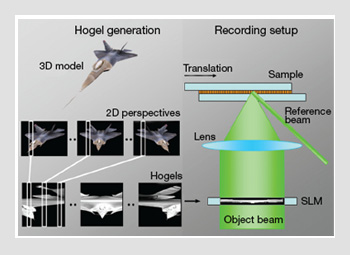 Hogel generation and recording set-up.
Hogel generation and recording set-up.
Our 3D display features a total horizontal viewing angle of 45° and a vertical view zone of about 15° with uniform brightness. The hologram is viewable for up to three hours on the photorefractive sample, with no need for intermediate projection tools or magnification between the recorded image and the viewer. The persistence is limited by the thermal dark decay of the PR space-charge field and can be enhanced by thermal fixing. The hologram can be completely erased within minutes by uniform illumination of the display with light within the material’s absorption band. A new hologram can then be recorded in the same location. We extensively used one of our samples for more than one year without any property degradation or material fatigue, successfully recording hundreds of holograms.
Future prospects for rewritable 3D displays
Creating a refreshable 3D display using a photorefractive polymer was quite a scientific and technical challenge, and there is still a lot to do before we reach the limits of this system. Our future work will target better resolution and contrast for the display. Indeed, the current angular and vertical resolutions match the human eye, but the horizontal resolution is undersampled due to the hogel lateral dimension.
Better optics in the recording setup should help to reduce the hogel size. We are currently working on larger size display fabrication and envision 1 x 1 ft.2 devices within a year. We hope to achieve color holograms by angular multiplexing of several holograms that can be readout by different color reading sources.
Full parallax will increase the number of hogels quadratically: From the 120 hogels recorded now for horizontal parallax only, full parallax will require 14,400 hogels (120 x 120), increasing the recording time for the complete hologram up to four hours. Since the recording time would be larger than the persistence time, the first hogels would disappear before recording of the hologram is completed. Thus, the recording time needs to be reduced significantly. We have already demonstrated a very fast response time and single pulse recording with PR polymer. Adapting this technique to the 3D display will realize full parallax displays with sufficient persistence.
We are currently using the so-called transmission geometry to record our holograms. This means that the image is replayed with a reading beam passing through the PR medium to be diffracted. The drawback of this geometry is that a dedicated light source is required to display the hologram.
Reflection displays, where the light is reflected back to the viewer by the display medium, may provide another option. They can use ambient light to replay the hologram and do not require monochromatic sources for color readout. More material engineering is required to obtain reflection holograms and good images. Some of our work has already shown promising results with reflection gratings.
Holodreams for the future
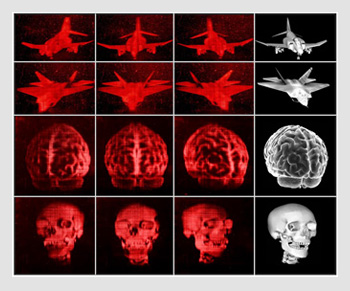 Horizontal parallax-only holograms. Images captured from the rewritable holographic 3D display with a still CCD camera. In a single row, the camera is moved sideways to show parallax: rotation and occultation. Between each row, the hologram is erased and a new set of data is recorded in the same sample location. The end column shows 2D perspectives used for generating the hogels.
Horizontal parallax-only holograms. Images captured from the rewritable holographic 3D display with a still CCD camera. In a single row, the camera is moved sideways to show parallax: rotation and occultation. Between each row, the hologram is erased and a new set of data is recorded in the same sample location. The end column shows 2D perspectives used for generating the hogels.
With our report of an updateable 3D display, everybody has the same question in mind: Will we ever realize a real-time, large-format holographic 3D video such as the holodeck? Such a technology would be greatly beneficial to a number of fields, including medicine, the military and scientific 3D imaging—not to mention all the people who crave realistic 3D cinema and computer games without goggles. Although there are significant technical challenges to reach at this point, 3D holographic video could someday be possible if we make improvements in the materials science of photorefractive polymers, image processing and data compression and optomechanical design.
Photorefractive polymers have the potential for sub-millisecond response times, which would make them suitable for real-time video. However, new recording schemes must first be developed that will allow us to take advantage of this fast response, as pixel-by-pixel recording is too slow to match the video rate (30 Hz).
A more serious challenge is figuring out how to generate and process the huge amounts of data that the 3D images require, although even this may not be insurmountable. The processor speed of computers has been steadily increasing over the last decades, and new image processing and compression algorithms allow reducing the data amount to manageable levels. Assuming that the outstanding issues are addressed in the next 5 to 10 years, perhaps every gamer and Star Trek enthusiast will have a holodeck in their living room…who knows?
[ Nasser Peyghambarian, Pierre-Alexandre Blanche and Robert Norwood are with the College of Optical Sciences, University of Arizona, Tucson, Ariz., U.S.A. Savas Tay is currently with the department of bioengineering, Stanford University. Michiharu Yamamoto is with Nitto Denko Technical, Oceanside, Calif., U.S.A.]
References and Resources
>> Zebra Imaging Inc.
>> L.H. Lin and H.L. Beauchamp. Appl. Opt. 9, 2088-92 (1970).
>> St. Hilaire et al. JOSA-A 9, 1969-78 (1992).
>> K. Meerholz et al. Nature 357, 479-500 (1994).
>> J.D. Downie and D.T. Smithey. Appl. Opt. 35 (1996).
>> B. Kippelen et al. Nonlinear Optics of Organic Molecules and Polymers, H.S. Nalwa and S. Miyata, eds., Chap 8., 507-623, CRC, Boca Raton, Fla., 1996.
>> B.L. Volodin et al. Nature 383, 58-60 (1996).
>> S.R. Marder et al. Nature 388, 845-851 (1997).
>> B. Kippelen et al. Science 279, 54-57 (1998).
>> P.-A. Blanche et al. JOSA-B, 17 (2000).
>> S.A. Benton. Selected Papers on Three-Dimensional Displays, SPIE Optical Engineering Press, Bellingham, Wash., 2001.
>> M.L. Huebschman et al. Opt. Exp. 11, 437-45 (2003).
>> C.-R. Lee et al. Appl. Phys. Lett., 83 (2003).
>> O. Ostroverkhova and M.E. Moerner. Chem. Rev. 104, 3267-314 (2004).
>> S. Tay et al. Appl. Phys. Lett. 85, 4561-3 (2004).
>> M.R. Chatterjee and S. Chen. Digital Holography and Three-Dimensional Display: Principles and Applications. T. Poon, ed., Chap 13., 379-425, Springer, New York, N.Y., 2006.
>> M. Eralp et al. Appl. Phys. Lett. 89 (11), 114105 (2006).
>> K. Iizuka. Opt. Photon. News, 17, 43-51 (2006).
>> M. Eralp et al. Opt. Express, 15(18), 11622-8 (2007).
>> SPIE Practical Holography XVI (Proc. SPIE, 4659, 2002) through XXI (Proc. SPIE, 6488, 2007).
>> S. Tay et al. Nature 451, 694–8, (2007).
>> J. Teteris and M. Reinfelde. Journal of Non-Crystalline Solids 353, 1450–3 (2007).
>> S.A. Benton and V.M. Bove Jr. Holographic Imaging, Wiley Inter-Science (2008).
